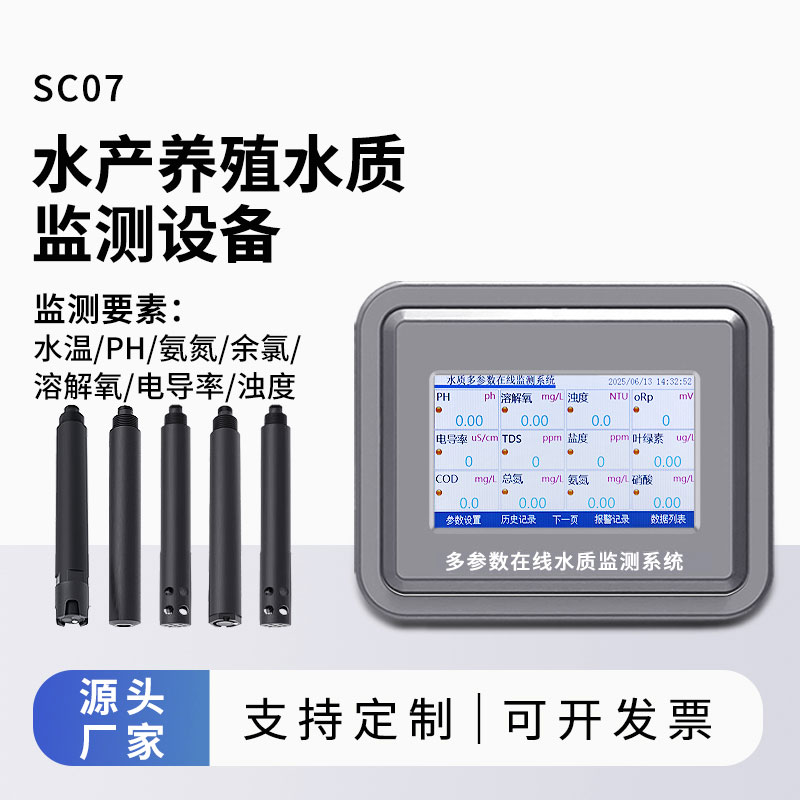
Aquaculture Water Quality Monitoring
Model:FT-SC07
Brand:fengtu
1. Aquaculture Water Quality Monitoring product introduction
Aquaculture Water Quality Monitoring can also monitor water temperature, ph, ammonia nitrogen, residual chlorine, dissolved oxygen, conductivity, turbidity parameters.SC07 Online Aquaculture Water Quality Monitoring is an instrument that can monitor water temperature, ph, ammonia nitrogen, residual chlorine, dissolved oxygen, conductivity, and turbidity online.It integrates corresponding sensors and measurement module communication storage, and can quickly and accurately record key parameters in the water body.At the same time, the instrument supports extended water quality multi-parameter sensors, including but not limited to pH, dissolved oxygen (DO), conductivity, turbidity, temperature, ammonia nitrogen, etc., which can be combined and configured according to different needs and applications, and record and store history Monitoring data and alarm history records support historical data export.xlsx.The RS485 interface supports the MODBUS-RTU communication protocol to facilitate users to freely communicate with PLC, DCS, configuration software, DTU and other equipment to connect and transmit data.
2.Aquaculture Water Quality Monitoring application fields
Online Aquaculture Water Quality Monitoring is widely used in the monitoring and control of various water bodies, including but not limited to the following fields:
1.Aquaculture monitoring: used to monitor aquaculture water quality such as ammonia nitrogen, PH, water temperature and other parameters in order to optimize the breeding environment and improve the production speed and product quality of aquatic products.
2.Groundwater monitoring: used to monitor the pH value, conductivity, temperature and other parameters of groundwater to detect and solve water quality problems in a timely manner.
3.River and lake monitoring: used to monitor the water quality conditions of rivers and lakes, such as dissolved oxygen, turbidity, ammonia nitrogen and other parameters, so as to take timely pollution control measures.
4.Marine monitoring: used to monitor the water quality conditions of the ocean, such as salinity, dissolved oxygen, temperature and other parameters, so as to detect and control marine pollution in a timely manner.
5.Sewage treatment: used to monitor the water quality parameters of sewage, such as pH value, COD, ammonia nitrogen, etc., in order to control and adjust the sewage treatment process.
6.Industrial production: used to monitor water quality conditions during industrial production, such as pH, conductivity, dissolved oxygen and other parameters, so as to adjust the process in a timely manner and ensure product quality.
7.Water plant: used to monitor the pH value, dissolved oxygen, turbidity and other parameters of tap water to ensure the safety and hygiene of tap water.
8.Scientific research: used for water quality monitoring in the field of scientific research, such as lake eutrophication, climate change, etc.
3.Technical features of Aquaculture Water Quality Monitoring
1.High reliability: suitable for long-term work in outdoor environments, with stable measurement and strong anti-interference ability.
2.Flexible and portable: Each probe can be freely combined, replaced independently, plug and play.
3.Scalability: A variety of sensors can be freely combined.
4.Various applications: on-site rapid measurement, emergency monitoring, or long-term online monitoring of groundwater, river water, lake water sources, and urban pipe network water.
5.Tough shell: ABS+PC material, anti-corrosion, can work continuously and normally for a long time.
6.Compact structure: can be installed in smaller places.
7.Communication connection: RS485 expansion interface, the master/slave interface is isolated and can communicate independently.
4.Aquaculture Water Quality Monitoring Technical Parameters
| show output | 4.3-inch touch screen with strong LED backlight, can be operated under direct sunlight |
| power supply | DC power supply: DC12V |
| Power consumption | The power consumption of the instrument is about 12V/1W |
| sound output | buzzer |
| Communication protocol | Standard RS485 Modbus-RTU protocol and device master/slave transmission channel support |
| Main materials | ABS+PC material |
| Storage temperature | -20 to 70℃ |
| operating temperature | -10 to 50℃ |
| Protection level | IP65 |
| size | 175mm*140mm*49mm(length×width×height) |
| weight | About 0.5KG |
5.Aquaculture Water Quality Monitoring sensor configuration (optional)
| serial number | name | Measuring range | principle | Measurement accuracy | Configuration | Remark |
| 1 | temperature | 0~50℃ | High-precision digital sensor | ±0.3℃ | ✔ | |
| 2 | pH | 0~14(ph) | Electrochemistry (Salt Bridge) | ±0.1PH | ✔ | |
| 3 | ORP | -1500mv~1500mv | Electrochemistry (Salt Bridge) | ±6mv | ||
| 4 | Conductivity | 0~5000uS/cm | contact electrode method | ±1.5% | ✔ | |
| 5 | Turbidity | 0~40NTU (low turbidity) | scattered light method | ±1% | Optional | |
| 0~1000NTU (medium turbidity) | scattered light method | ±1% | ||||
| 0~3000NTU (high turbidity) | scattered light method | ±1% | ✔ | |||
| 6 | Dissolved oxygen | 0~20mg/L | fluorescence lifetime method | ±2% | ✔ | |
| 7 | Ammonia nitrogen | 0-1000.00mg/L (default) 0-100.00mg/l/ (customizable) | Ion selective electrode method | 10% of reading, ±0.5℃ | ✔ | |
| 8 | suspended solids | 0~2000mg/L | scattered light method | ±5% (depending on sludge homogeneity) | ||
| 9 | Residual chlorine | 0~5.00 mg/L | Ion selective electrode method | ±5% of reading | ✔ | |
| 10 | Chloride ion | 0-3500.0mg/L | Ion selective electrode method | ±5% | ||
| 11 | Total hardness | 0~1000.0mg/L | Ion selective electrode method | ±10% of reading | ||
| 12 | cod | 0~500mg/L | UV254 absorption method | ±5% | COD and chlorophyll are equipped with automatic cleaners to prevent biological adhesion and avoid light window pollution to ensure long-term monitoring is still stable; the automatic cleaning time and cleaning frequency can be set, and the power consumption is 0.7W | |
| 13 | Chlorophyll | 0~400ug/L | Fluorescence method | R2>0.999 |
Article address:https://www.sqqx.net/en/online-water-quality/Aquaculture-Water-Quality-Monitoring.html

 +86 15898932201
+86 15898932201 Get a Free Quote
Get a Free Quote



